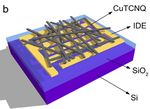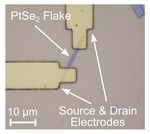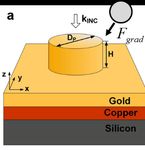PHD & MSC PROJECTS 2020-2021 - PROFESSOR ANN ROBERTS PROFESSOR KENNETH CROZIER
←
→
Page content transcription
If your browser does not render page correctly, please read the page content below
PhD & MSc PROJECTS 2020-2021 PROFESSOR ANN ROBERTS ANN.ROBERTS@UNIMELB.EDU.AU PROFESSOR KENNETH CROZIER KENNETH.CROZIER@UNIMELB.EDU.AU PLASMONICS AND METAMATERIALS The name ‘metamaterial’ has been adopted to describe any artificially produced, structured material designed to have optical properties not usually exhibited by naturally occurring matter and plasmonics refers to the utilisation of free- electron excitations at boundaries between metals and dielectrics. Projects in this area involve investigating applications in document security, sensing, imaging and/or quantum emission control and will combine a mixture of theory/modelling, nanofabrication using the world-class facilities at the new Melbourne Centre for Nanofabrication and optical characterization using the facilities within the School of Physics and the Department of Electrical and Electronic Engineering. Collaborators include ANU, RMIT, UTS, UWA, Purdue University, University of California at Berkeley, and the Reserve Bank of Australia. This document describes projects offered by Prof Ann Roberts and Prof Kenneth Crozier. These projects are supported by an ARC Linkage Project, ARC Discovery Projects and the new ARC Centre of Excellence for Transformative Meta-Optical Systems: tmos.org.au. STRUCTURAL COLOURATION AND FILTERS Throughout human history, humans have used colour for coding information, differentiating between objects and for entertainment. Most manufactured objects we perceive as possessing a particular colour have been coated with a pigment or impregnated with a dye. These, however, fade with time, can be toxic and their use adds an additional layer of complexity to manufacturing and subsequent recycling of materials. As a consequence, there is considerable interest in being able to replicate the colour spectrum without the introduction of additional materials. We are undertaking research into creating structural colour using an approach taking advantage of localised plasmonic resonances in aluminium and creating ‘plasmonic pixels’. An example is shown above right. The different colours are associated with different aluminium nanostructures on a silicon substrate. We are also collaborating with researchers in the School of Biosciences into structural colouration and polarization in beetles. ADVANCED HOLOGRAMS Holograms use diffraction to produce three dimensional light fields and are used for document security (e.g. credit card security features), sensors, and data storage. There is also much interest in employing them in advanced displays. We are developed new types of holograms based on nanostructured materials. A hologram records the wavefront of light from an object, but it is usually not an image itself, and looks unintelligible under diffuse ambient light (see diagram on right (upper)). We have recently developed a new paradigm to encode a colour hologram onto a colour printed image (see right (lower)). The printed image can be directly viewed under the white light illumination, while a low-crosstalk colour holographic image can be seen when the device is illuminated with red (R), green (G), and blue (B) laser beams. The device is a dielectric metasurface that consists of titanium dioxide (TiO2) cones on a glass substrate. Reference: Advanced Functional Materials 1906415 (2020).
METASURFACE-ENABLED PHOTODETECTORS (VISIBLE WAVELENGTHS) Conventional photodetectors are sensitive to only the intensity of light and ‘blind’ to other properties such as wavelength and polarization. Important information about objects, however, can be encoded in these invisible characteristics of light and being able to visualize or measure them underpins many imaging and communication methods. Most optical components are relatively bulky and expensive and the ability to create photodetectors integrated with ultra-thin surfaces that can convert information to intensity will facilitate new applications in medicine and industry. The image at left shows a microscope image of a Si photodetector integrated with nanoantennas (inset) with sizes that produce red, green and blue sensitive sub-pixels respectively. Each pixel is 20 µm in size. As part of the ‘detect’ them of TMOS we are extending this research into other parts of the spectrum. This project will involve aspects of electronics, optics and nanotechnology and students will learn state-of-the art nanofabrication skills as well as the ability to establish optical characterization systems. METASURFACE-ENABLED PHOTODETECTORS (INFRARED WAVELENGTHS) Mid-wave infrared (MIR, approx =2-25 m) radiation is by nature characterized by low photon energy and is thus usually detected by semiconductor materials with small band gaps. At room temperature, charge carriers are thermally generated in such materials at very high rates. Cooling the detector mitigates this, yet adds significantly to size, weight, power consumption and cost. This has prompted research into room temperature MIR detectors. Much of this work has concerned epitaxial materials (e.g. mercury cadmium telluride) that are incompatible with silicon technology. Here, we aim to harness recent breakthroughs in nano- optics and in two dimensional materials to realize photodetectors for high-performance, large-format and low-cost MIR imaging at room temperature. We have demonstrated MIR photodetectors from a variety of advanced materials, including graphene, black phosphorous- moylbdenum disulphide (Nature Photonics 12, 601 (2018)), tellurium (ACS Nano 12, 7253 (2018)), platinum diselinide (see image on left (top)), and Cu TCNQ (see image on left (bottom)). For the latter, we demonstrated very broad photoresponse, extending from the visible (450 nm) to the long- wave infrared (8.3 µm). TUNABLE META-OPTICS WITH PHASE-CHANGE MATERIALS Once fabricated, the structures discussed above have a fixed response. In many applications, however, it is desirable to dynamically tune or switch their properties such as their colour or polarization properties. This can be achieved through the introduction of materials that have optical properties that can be modified by changing their temperature or applying a voltage. This project will involve the modelling, design, fabrication and optical characterization of devices incorporating phase change materials such as vanadium dioxide. IMAGING AND OPTICAL TWEEZERS We have a long-standing interest and strong track-record in the development of novel imaging techniques and in optical tweezers. Applications range from live-cell imaging to studying dynamic cellular and sub-cellular processes through to understanding issues confronting cultural materials conservators and the implementation of next-generation photonic components. Students working in this area will work in a highly interdisciplinary area, and acquire skills in instrumentation, computer modelling, biological science or cultural materials and photonics.
NANOPHOTONIC DEVICES FOR INFORMATION PROCESSING AND IMAGING Nanophotonic devices have the capacity to be able to sense information carried in an optical wavefield in the form of phase or polarization. This opens up the possibility of novel devices for imaging and manipulating and controlling the wealth of information carried by electromagnetic waves. The nanostructure shown at right is sensitive to phase gradients in an incident field and could provide an avenue for imaging transparent objects such as cells. Edge enhancement of an amplitude object (the number ‘2’) is demonstrated using a ‘perfect’ absorber Salisbury screen (lower image). This project, part of the TMOS research activities, would involve theory, modelling and the optical characterisation of these devices and potentially imaging biological samples. WAVEFRONT SENSING WITH METASURFACES This project extends the research being undertaken into phase imaging to explore the role that meta-optics may play in more general wavefront sensing with a view to developing camera-mounted devices to provide information about distortions introduced by the atmosphere or water. It will have a theoretical component aimed at, firstly, designing surfaces producing a characteristic response to different modes of propagation and, secondly, using this information to extract quantitative information. This research has the potential to inform applications as diverse as ophthalmology, astronomy and space science. GHOST-IMAGING WITH METASURFACES Images can be created using so-called ghost or single-pixel approaches where characteristic patterns are projected onto a sample and the resultant total intensity collected with a non-imaging, single-pixel sensor. Patterns can be created with, for example, a digital mirror device such as those used in projectors. This approach to imaging enables imaging outside the visible spectrum where the cost and performance of pixelated image sensors can be problematic. Projects in this area will explore algorithms that take advantage of the unique properties of metasurfaces and/or use ghost imaging to test infrared sensors. OPTICAL NANOTWEEZERS One half of the Nobel Prize in Physics for 2018 was awarded to A. Ashkin, “for the optical tweezers and their application to biological systems.” Optical tweezers are an important scientific tool in many fields. They use the forces exerted by focused laser beams to trap and manipulate particles. Conventional optical tweezers employ lenses to focus laser beams. Due to the diffraction limit, these can only focus light to spots no smaller than roughly half the wavelength. This sets a limit to the force that can be exerted by conventional optical tweezers on a particle of a given size (with a given refractive index) with a given laser power. This makes it challenging to trap very small particles. We overcome this limitation by using nanostructures, rather than lenses, to concentrate light. These include gold nanostructures (e.g. ACS Photonics 5, 2850 (2018)) and silicon nanoantennas (e.g. ACS Photonics 5, 4993 (2018)). MORE INFORMATION Contact ann.roberts@unimelb.edu.au kenneth.crozier@unimelb.edu.au University web profiles Ann Roberts Ken Crozier ORCiD publication lists Ann Roberts Ken Crozier ARC Centre of Excellence for Transformative Meta-Optical Systems Optical Physics Group Electronic and Photonics Systems Group
You can also read

























































